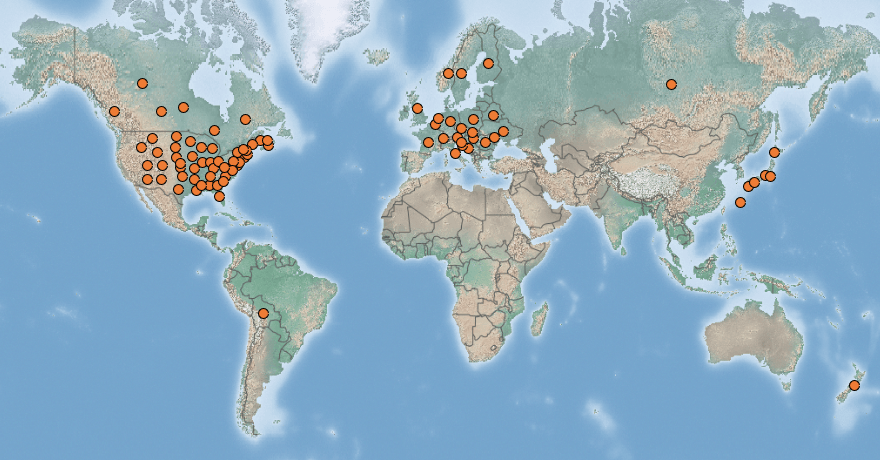 |
Coneflower | Status LU: established. 1st record: LU & ITW 1887. |
 |
Spléckbliedrege Sonnenhutt | Status Eur.: established. 1st record: <1625.1 |
 |
Rudbéckie laciniée | RA: ISEIA: C1. Harmonia+: 0,17. |
 |
Schlitzblättriger Sonnenhut | Wikipedia: |
 |
Slipbladige rudbeckia | Back to the list of neophytes |
Contents
Report the species
→ Report Rudbeckia laciniata to the National Museum of Natural History.
Brief description

Status and distribution in Luxembourg
Records of Rudbeckia laciniata L. in Luxembourg. Data source: Recorder-Lux, iNaturalist & GBIF, 2025-07-02.
Rudbeckia laciniata L. was first mentioned for Luxembourg in the wild in the surroundings of Mersch by Feltgen (1901: 254).
The oldest herbarium specimen of Rudbeckia laciniata L. at the MNHNL was collected on 20 August 1935 by Jos. Witry in gardens in Schifflange (Specimen № 50794, MNHNL 2000-). The next scientific record that we know of was made by Léopold Reichling (1921-2009) on 12th June 1961 near the river Alzette in the municipality of Walferdange (MNHNL 2000-).
Currently, 2 records of coneflower are accessible through the MNHNL-mdata portal (MNHNL, iNaturalist & GBIF 2019).
This melliferous species from North America is naturalised in Europe, especially in central Europe. River and canal banks, river gravel, sometimes wasteland. Sometimes subspontaneous or adventitious. Sometimes cultivated for garden ornament (Lambinon & Verloove 2012: 719).
The species is comparable to Helianthus tuberosus in its ecology but is much less common in Luxembourg.
Risk assessment
ISEIA protocol
C1 (2+2+2+2) (Ries et al. 2013: 19).
Harmonia+ protocol
Overall risk score 0,17 = (Overall Invasion score 0,51 x Overall Impact score 0,33) (Ries et al. 2020).
 Invasion
Invasion0,33

 Impact
Impact0,17

 Risk
RiskWorldwide distribution
Bibliography
- Branquart, E., S. Vanderhoeven, W. Van Landuyt, F. Van Rossum & F. Verloove, 2010. Harmonia database: Rudbeckia laciniata L. Harmonia version 1.2, Belgian Forum on Invasive Species. URL: http://ias.biodiversity.be [accessed on 2019-10-15]
- CABI, 2019. Rudbeckia laciniata. In: Invasive Species Compendium. Wallingford, UK: CAB International. URL: www.cabi.org/isc [accessed 2020-03-02]
- Feltgen, E., 1901. Mersch sowie nächste und weitere Umgebung, zum Gebrauch für Naturfreunde. Bulletin de la Société des naturalistes luxembourgeois 11: 246-277.
- Lambinon J. & F. Verloove, 2012. Nouvelle flore de la Belgique, du grand-duché de Luxembourg, du Nord de la France et des régions voisines. Sixième édition. Avec la collaboration de L. Delvosalle, B. Toussaint, D. Geerinck, I. Hoste, F. Van Rossum, B. Cornier, R. Schumacker, A. Vanderpoorten et H. Vannerom. Jardin botanique national de Belgique, Meise. CXXXIX + 1195 pp. ISBN : 9789072619884.
- MNHNL, 2000-. Rudbeckia laciniata L. in Recorder-Lux, database on the natural heritage of the Grand Duchy of Luxembourg. Musée national d’histoire naturelle, Luxembourg. URL: https://mdata.mnhn.lu [Accessed 2019-10-15]
- MNHNL, iNaturalist & GBIF, 2019. Rudbeckia laciniata L. in MNHNL-mdata, online portal combining species observation from Recorder-Lux, iNaturalist and GBIF. National Museum of Natural History, Luxembourg. URL: https://mdata.mnhn.lu [Accessed 2019-10-15]
- Ries, C. & Y. Krippel, 2021. First records of 56 invasive alien vascular plants in Luxembourg. Bulletin de la Société des naturalistes luxembourgeois 123: 115-127. [PDF 241 KB]
- Ries, C., Y. Krippel & M. Pfeiffenschneider, 2020. Risk assessment after the Harmonia+ protocol of invasive alien vascular plant species in Luxembourg. Bull. Soc. Nat. luxemb. 122: 197-205. [PDF 132 KB]
- Ries, C., Y. Krippel, M. Pfeiffenschneider & S. Schneider, 2013. Environmental impact assessment and black, watch and alert list classification after the ISEIA Protocol of non-native vascular plant species in Luxembourg. Bull. Soc. Nat. luxemb. 114: 15-21. [PDF 652 KB]
Suggested citation of this webpage
Ries, C., M. Pfeiffenschneider & Y. Krippel (Eds.), 2025. Rudbeckia laciniata L. In: neobiota.lu - Invasive Alien Species in Luxembourg. National Museum of Natural History, Luxembourg. URL: https://neobiota.lu/rudbeckia-laciniata/ [Accessed 2025-07-02].
Page content last updated on 2021-03-11. Last proofread by Caroline Grounds on 2019-11-21.
- Cf. CABI 2019.[↩]


